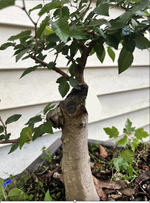zeejet
Mame
I recently got a great deal on a Korean Hornbeam that is maybe a year or two out from a trunk chop. However, the material has some issues near the chop - namely two large water spouts that look like they also need to go but I am unsure as to how to remove them without creating additional issues since they may overlap with the existing trunk chop wound.
Do I leave these alone for now? Or do I start gradually reducing them and live with the fact that it may take a long time to heal? Are there other options or approaches to this?



Do I leave these alone for now? Or do I start gradually reducing them and live with the fact that it may take a long time to heal? Are there other options or approaches to this?





